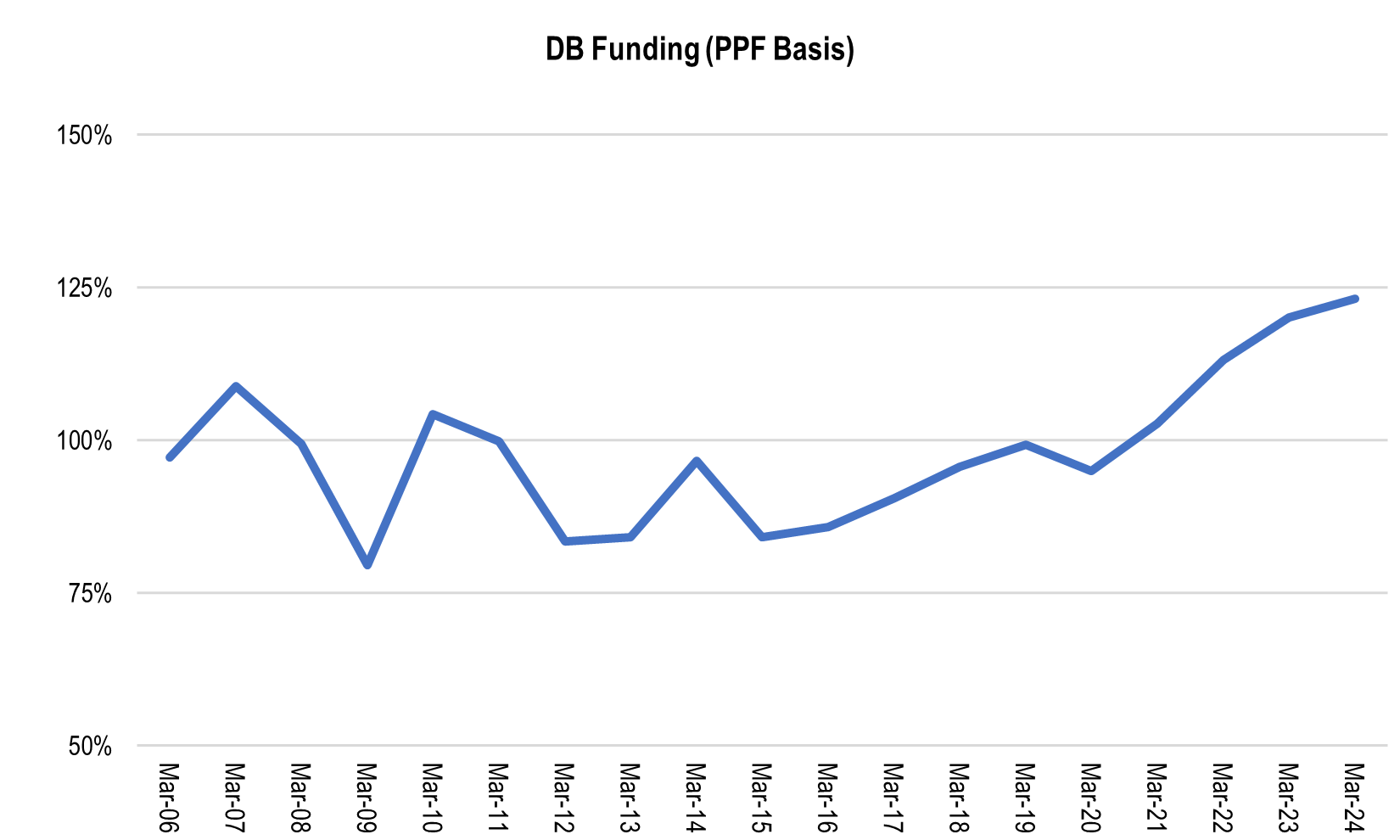
Global pension trends: What to expect in 2026
KEY POINTS
Global backdrop
The world’s pension assets are concentrated in 22 major markets and total some US$58.5trn, as of the end of 2024, with the US accounting for 65%. In all, the top seven markets – the US, UK, Japan, Netherlands, Switzerland, Australia, and Canada – account for US$53.5trn.1
Assets grew in 2025, supported by positive performance and contributions, though they remain below 2021 highs. The long-running shift from defined benefit (DB) to defined contribution schemes (DC) continues, with DC assets growing faster (6.7% per annum vs. 2.1%) and now representing an increasing share of totals.

Source: Thinking Ahead Institute, Global Pension Asset Survey, 2025
Pension fund allocations to equities and bonds have gradually declined since 2003, while exposure to private markets, real assets, and alternatives has increased to around 20%. Average allocation at end-2024 came in at 45% equities, 33% bonds, 20% others, and 2% cash.2 Home bias continues to fall. Private credit, infrastructure, and private equity remain the fastest-growing asset classes, supported by outsourcing and partnerships due to capacity constraints. ESG integration has become mainstream as frameworks like the Corporate Sustainability Reporting Directive (CSRD) and Securities and Exchange Commission (SEC) rules make sustainability risk assessment mandatory.
- Thinking Ahead Institute, Global Pension Asset Survey, 2025
- {https://www.thinkingaheadinstitute.org/content/uploads/2025/02/GPAS-2025.pdf;Global Pension Asset Survey 2025}
Country highlights
In the UK, the average DB funding ratio reached around 125% in 2024.3 DB portfolios remain bond-heavy (at circa 70%), with growing private asset sleeves. De-risking via buy-ins/buy-outs will continue, with cashflow driven investment (CDI) strategies expanding. DC assets (£1.9trn) are set to surpass DB by the late 2020s.4The nascent “superfunds” should increase the consolidation of the sector by offering insurance-like guarantees at lower costs.
Policy initiatives aim for 10% allocations to private markets by 2030 and 50% invested domestically under the Mansion House Compact, supported by the Long-Term Asset Fund structure, and are promoting consolidation into large master trusts for the UK DC market.

Source: PPF, Purple Book, 2024
In the US, DC dominates private sector pension arrangements, while federal, state, and other public pension funds remain mostly DB. Allocations to private credit and infrastructure continue to rise, supported by lifecycle designs retaining equity exposure. This trend is expected to continue in 2026.
The €1.6trn Dutch pension system is transitioning from DB to DC under the Future Pensions Act. Over half of the participants will migrate by mid-2026, a pivotal year for reallocations and hedge adjustments. Reduced duration and higher risk budgets will most likely shift portfolios toward equities, credit, and private assets within CDI structures.
Between 2023 and 2025, pension funds increased their interest rate hedge ratios above 75% in preparation for the transition, and others decreased their equity position to strategic minimum levels. Post-transfer, funds are expected to unwind part of those hedges, reducing structural demand for ultra-long Dutch and Euro government bonds as well as swaps and possibly other duration sources. The new target duration will be significantly lower compared to the current system.

Source: DNB, Invested Pension Assets, 2025
The well-funded Scandinavian retirement systems with high sustainability standards are also increasing exposure to infrastructure and private credit, emphasizing energy efficiency and diversification.
The conservative German structures are gradually embracing capital-market and illiquid investments. Larger corporations are enhancing liability-driven investment (LDI), while small and mid-sized enterprises are exploring funding and higher-yielding strategies. Incremental moves into private credit and infrastructure debt are expected.
Across the rest of continental Europe, asset growth persists, albeit unevenly. Regulators push broader coverage and cross-border pension integration, and allocations are migrating toward private markets – especially to infrastructure and private credit in European Long-Term Investment Funds, similar to the UK’s long-term asset funds – as well as quality bonds and diversified equity.
Australian Superannuation funds remain equity-heavy with significant internal private investments. Data, valuation, and operational infrastructure underpin scalability. Domestic investment initiatives mirror the UK’s approach. Similarly, the large Canadian plans blend internal and external management, investing heavily in systems and data for private markets designed to harvest organizational alpha (people, processes, governance). Partnerships with insurers in infrastructure and private credit are expanding.
- {https://www.pwc.co.uk/press-room/press-releases/research-commentary/2024/uk-db-pension-schemes-reach-new-record-funding-level-ahead-of-po.html;UK DB pension schemes reach new record funding level ahead of potential pensions overhaul}
- A small minority of UK DB funds are actually re-risking since their solvency has improved (thanks to higher discount rates).
Asset-class outlook
Public markets
DC outcomes typically improve with equity allocations, and we expect continued usage of global equity, factor, and low-volatility sleeves. Home bias keeps falling, and increased governance favors global diversification. At the same time, the higher risk of listed equities, currently at all-time highs, calls for risk management strategies.
Fixed income remains the core risk-management anchor for DB pension funds, particularly in the UK and the Netherlands. In DC, we expect a greater use of investment-grade (IG) credit, inflation-linked bonds, and short duration as ballast in glidepaths. We see a migration towards structured finance, with an emphasis on highly rated instruments, such as Collateralized Loan Obligations (CLOs) and asset-backed securities (ABSs), as well as fixed income pension solutions from insurers. Further interest rate cuts are uncertain, given European and American monetary policy and fluctuating inflation expectations. As a result, we anticipate modest upside potential for bond prices in 2026. In the event of a reversal of trend in the equity markets, listed bond allocations are unlikely to provide significant relief.
In the current market configuration, protection of equity allocations remains prudent. With low implied volatility, equity protection can be achieved cost-efficiently with listed equity index options and futures.
Private markets
The clear direction is toward more private investments, often via third-party specialists, with a notable increase in operating spending toward risk and data infrastructure, including greater use of artificial intelligence in investment modeling. The largest talent gaps are likely to remain in private markets and co-investments for pension funds with a limited workforce. The solution appears to be partnerships between institutional investors and retirement institutions, which are becoming increasingly common.
We expect strong investor interest in resilience, inflation linkage, and energy transition exposure of infrastructure debt and equity. We note a growing demand for infrastructure debt as a defensive income sleeve. Sustainability priorities include energy efficiency, carbon, climate resilience, and community benefits. The top net inflow expectation among large asset owners is for private credit, as it is used for yield, downside protection, and diversification. We expect large growth in scale via external specialists, co-investments, and secondaries. We also anticipate that exposure to private markets, particularly private credit, is likely to occur through diversified private market funds rather than sub-optimal and expensive funds of funds.
Moderate net increases in private equity allocations are expected. There is nevertheless a lot of sensitivity when it comes to exit and liquidity conditions. The broader use of secondaries and continuation vehicles, coupled with valuation transparency, should hopefully start to improve sentiment.
There is mixed near-term sentiment for real estate. There may be increased interest in logistics, residential, and retrofit or energy-efficiency themes as markets stabilize and interest in sustainable investments renews.
Sustainability and ESG
The concept of sustainable and ESG investments continues to evolve, encompassing new approaches and innovations across asset classes. It is now embedded in most investment strategies of non-US plans, even though the terminology usage has cooled in some markets. In infrastructure and private equity, energy efficiency and climate resilience are persistent drivers of allocation.
Despite political headwinds in the US and cost-of-living fatigue in Europe, global surveys show roughly 60% of pension investors plan to increase ESG allocations, especially through passive and index-based strategies that reflect new regulatory benchmarks. The share of ESG-linked assets in Europe is therefore projected to rise from €6.2trn to €9.4trn by 2027, with greater use of passive ESG ETFs.
The next wave of DC design will focus on impact and sustainability outcomes rather than box-ticking. Members show increasing preference for climate-aligned and transition-oriented strategies, but transparency and data integrity remain ongoing concerns.
Closing DB and exiting DC
The use of life insurance policies is now common for DB in the UK and US. Many UK DB funds have focused their buy-in / buyout transactions on the lowest-risk and often largest cohort (the pensioners) but must now address the rest of the pension fund members. We expect similar developments in DC as demonstrated in the US, where participants can purchase insurance guarantees (i.e. variable annuities) on an ongoing basis and at institutional rates. In this framework, insurers bid on guaranteed withdrawal rates as the participants’ income base grows annually. Upon retirement, participants can “activate” their benefit and draw income from the policy or annuity.
Conclusions and asset allocation implications
|
Sources
OECD Pension Markets in Focus 2024 and Pensions Outlook 2024
OECD on DC design (equity in defaults), 2024
IPE’s DB to DC shift, equity in DC and payout design, Jun 2025
Thinking Ahead Institute GPAS, 2025
PPF’s Purple Book, 2024
Mercer’s Large Asset Owner Barometer, 2025
IFM Investors’ Private Markets 700, 2025
HSBC, Dutch reform market impact, Oct 2025
HSBC, UK pensions surplus, de-risking persistence, and gilt buyer dynamics, Jan 2025
NatWest, A Big Week for Pensions, Jun 2025
HBS, RTX’s lifetime income strategy: shaping the future of retirement, May 2025
Congress, U.S. Retirement Assets: Data in Brief, 2023
SEC, SEC Adopts Rules to Enhance and Standardize Climate-Related Disclosures for Investors, December 2024
House of Commons Library, Pensions: Defined Benefit Superfunds, July 2025
Disclaimer
Not for Retail distribution: this document is intended exclusively for Professional, Institutional, Qualified or Wholesale Investors / Clients, as defined by applicable local laws and regulation. Circulation must be restricted accordingly.
Companies shown are for illustrative purposes only. It does not constitute investment research or financial analysis relating to transactions in financial instruments, nor does it constitute an offer to buy or sell any investments.
Risk Warning
Investment involves risk including the loss of capital.
The information has been established on the basis of data, projections, forecasts, anticipations and hypothesis which are subjective. This analysis and conclusions are the expression of an opinion, based on available data at a specific date. Due to the subjective aspect of these analyses, the effective evolution of the economic variables and values of the financial markets could be significantly different for the projections, forecast, anticipations and hypothesis which are communicated in this material.
This document is being provided for informational purposes only. The information contained herein is confidential and is intended solely for the person to which it has been delivered. It may not be reproduced or transmitted, in whole or in part, by any means, to third parties without the prior consent of the AXA Investment Managers US, Inc. (the “Adviser”). This communication does not constitute on the part of AXA Investment Managers a solicitation or investment, legal or tax advice. Due to its simplification, this document is partial and opinions, estimates and forecasts herein are subjective and subject to change without notice. There is no guarantee forecasts made will come to pass. Data, figures, declarations, analysis, predictions and other information in this document is provided based on our state of knowledge at the time of creation of this document. Whilst every care is taken, no representation or warranty (including liability towards third parties), express or implied, is made as to the accuracy, reliability or completeness of the information contained herein. Reliance upon information in this material is at the sole discretion of the recipient. This material does not contain sufficient information to support an investment decision.
© 2025 AXA Investment Managers. All rights reserved.


